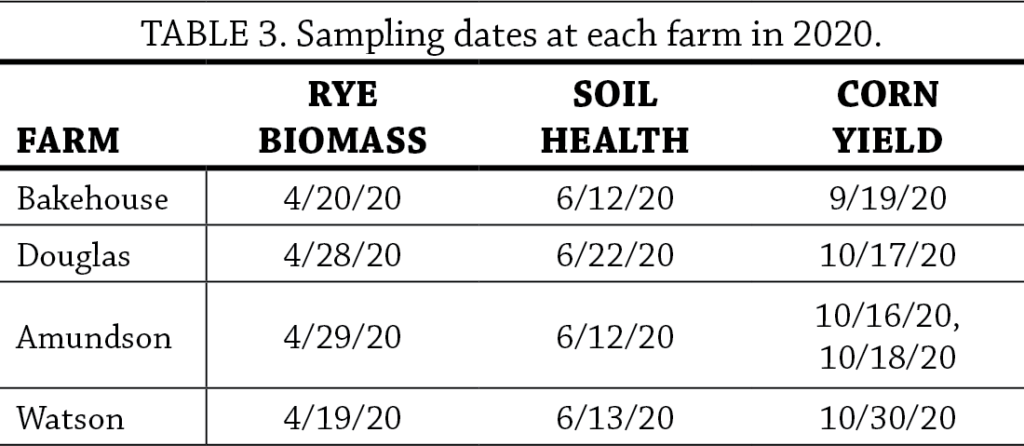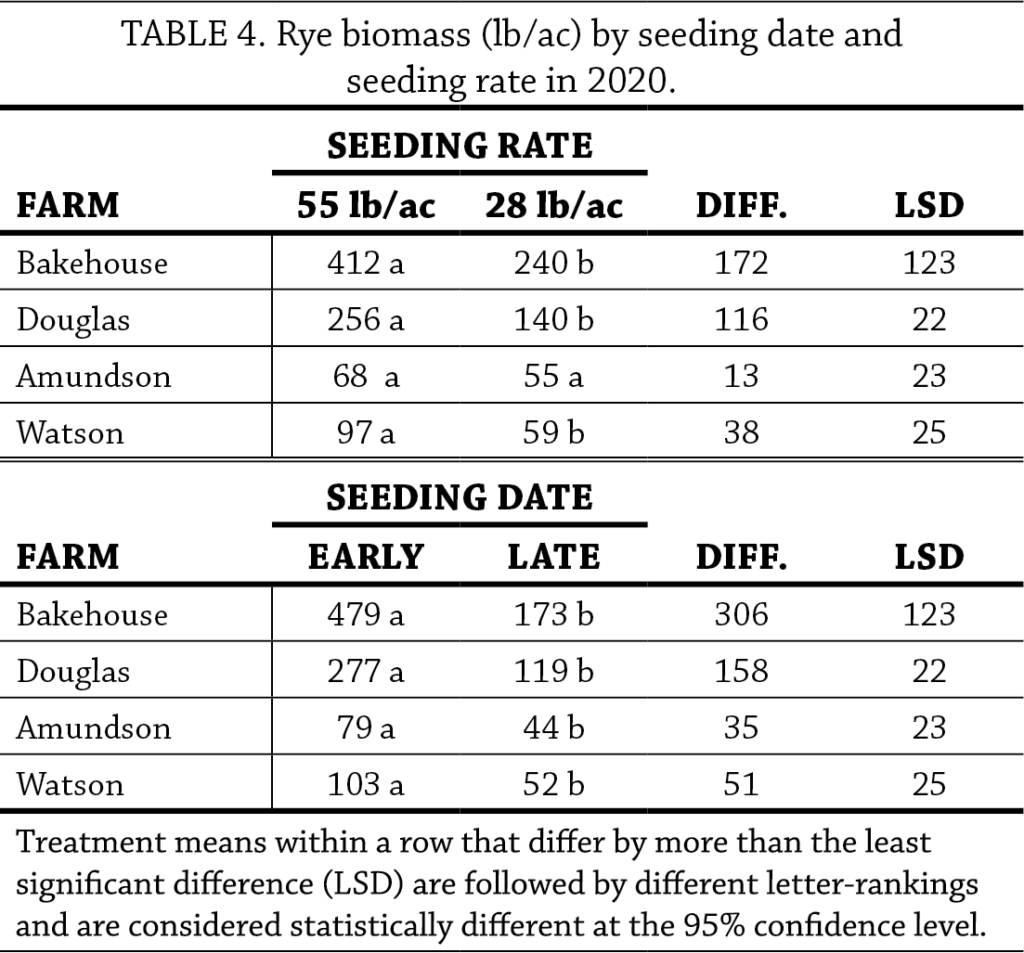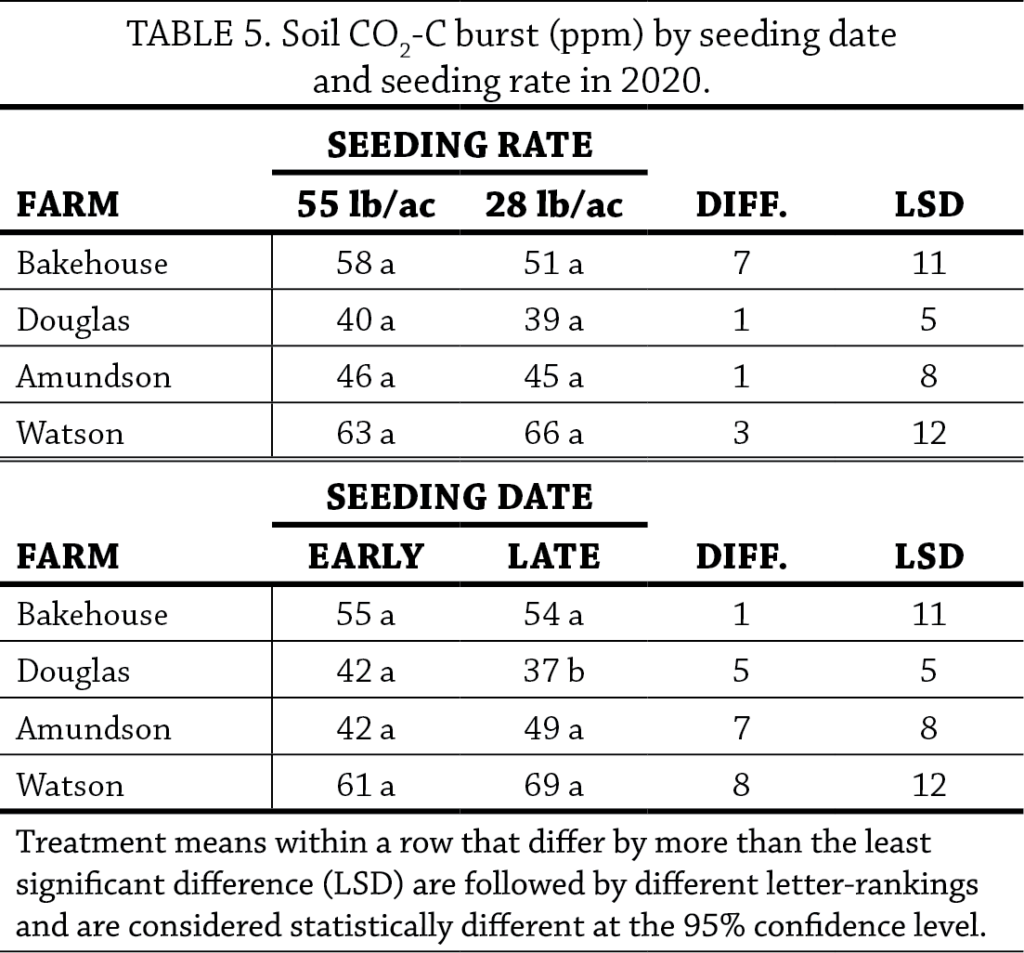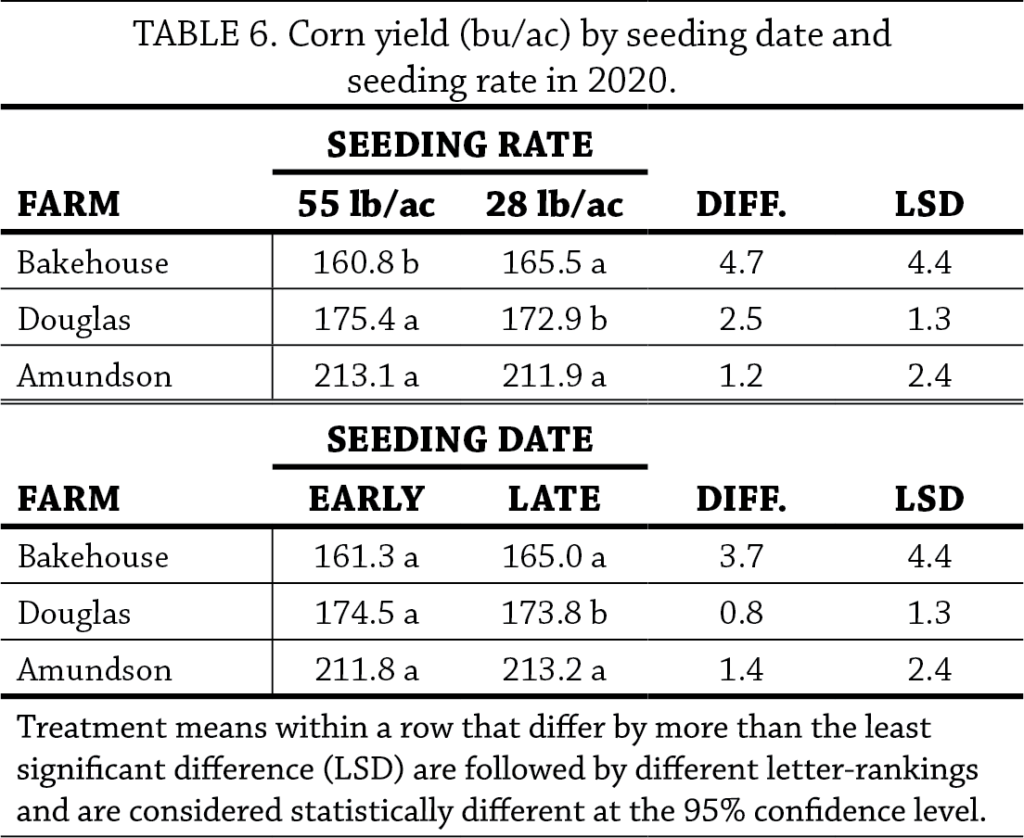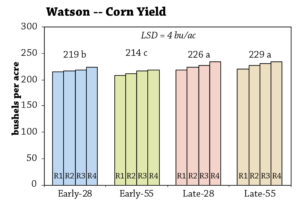In a Nutshell:
- Strategies are needed to offset the cost of cover crops that precede corn while minimizing yield drag and seedling diseases and maximizing cover crop benefits.
- In the second year of a two-year project, four cooperators compared the effects of planting a fall cereal rye cover crop earlier versus later and of reducing the seeding rate from 55 lb/ac to 28 lb/ac on indicators of corn crop success and cover crop performance.
Key Findings:
- Only one cooperator was able to reduce the seeding rate of rye without sacrificing rye biomass, soil health or corn yield. At the remaining farms, reducing the rye seeding rate reduced biomass with different impacts on soil health and corn yield.
- Seeding rye earlier compared to later consistently resulted in more biomass, and two cooperators who generated more biomass as a result of seeding early were able to do so without sacrificing corn yield.
- At one farm, corn yields where rye was seeded late were greatest irrespective of the seeding rate, and corn yields were lowest where rye biomass was seeded early and at the high rate. An economic analysis for this site revealed greater returns on investments from seeding later at the reduced rate compared to seeding earlier, but this does not account for any long-term financial (or environmental) benefits cover crops may provide.
Background
To increase the number of corn and soybean acreage planted to cover crops, growers will require strategies for maximizing cover crop benefits while keeping costs low and minimizing yield drag in corn. Unlike soybean seedlings, corn seedlings are particularly sensitive to competition with cover crops for sunlight, water and nutrients, and they run the risk of becoming infected with diseases transmitted from cereal rye if certain management precautions are not taken.[1] Currently, best management practices dictate that a cereal rye cover crop be terminated two weeks prior to planting corn to avoid these risks; however, this shortens the growing period of cereal rye, which may lessen its benefit.
A group of seven PFI cooperators conducted experiments on their farms in 2019 to evaluate strategies intended to maximize cover crop benefit while minimizing costs and damage to a subsequent corn crop.[2]
The cooperators compared combinations of two cereal rye seeding rates (28 lb/ac, 55 lb/ac) and two seeding dates (early, late) and measured their effects on cereal rye biomass, corn yield, rye groundcover, soil health and corn seedling disease. Their objective was to determine if seeding early might allow them to reduce the volume and cost of cover crop seed they plant without sacrificing corn health and cover crop benefits.[3] They also hoped to determine if seeding cereal rye at 55 lb/ac later in the season might be worth the expense and allow them to recuperate any potential losses of cover crop benefits caused by delayed fall planting.
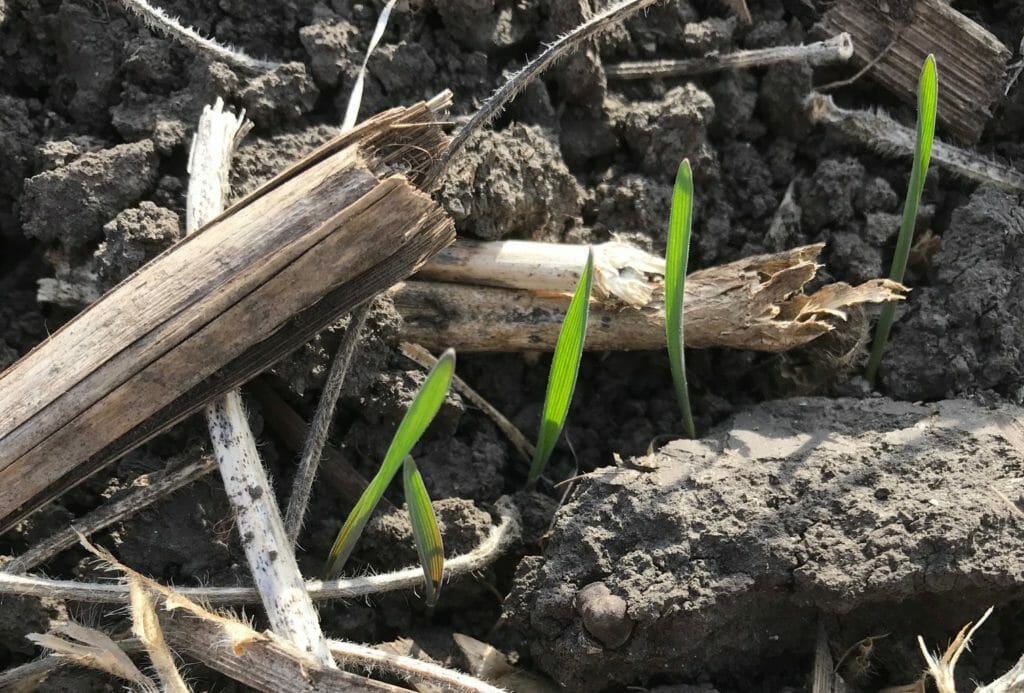
Jon Bakehouse planted his late-seeded rye 30 days after planting his early-seeded cereal rye. The rye pictured here was seeded early (Oct. 21, 2019) at 55 lb/ac and is 30 days old. Photo taken Nov. 20, 2019.
Generally, they found that while reducing the seeding rate of rye did reduce cover crop costs without sacrificing the success of the subsequent corn crop or soil health, the practices of reducing the seeding rate as well as seeding later both had the undesirable consequence of reducing cereal rye biomass at five farms and groundcover at the only farm that measured it.
Furthermore, of the two cooperators that had their fields sampled for the presence of corn seedling diseases, both found that neither reducing the seeding rate nor planting later helped to reduce disease pressure in their corn.
Four cooperators conducted this trial again in 2020 to verify findings from the first year. They evaluated the effects of the same treatments (early, late; 55 lb/ac, 28 lb/ac) on cereal rye biomass, soil health, corn yield and profitability.
Methods
Design
Cooperators established treatments the fall of 2019 by planting cereal rye in strips on each of the seeding dates and at each of the seeding rates (Table 1). Cereal rye followed soybean at all sites. At each farm, growers arranged treatment strips in a split-plot randomized complete block design. In this design, a block of land is divided into two whole plots and the levels of the seeding date treatment (early, late) are randomly assigned to a whole plot. After assigning treatments to whole plots, both whole plots are further divided into two subplots to which the levels of the seeding rate treatment (28 lb/ac, 55 lb/ac) are randomly assigned (Figure A1). Growers replicated each treatment four times for a total of 16 strips at each farm. This design allowed us to conduct statistical analyses and assess the effects of the seeding date and seeding rate treatments.
The spring after establishing rye treatments, cooperators chemically terminated rye and planted corn in all strips (Table 2).
Weed and nutrient management was unique at each farm and was applied equally to all strips.
Bakehouse applied 70 lb N/ac and 55 lb S/ac as UAN(32) and ammonium thiosulfate on April 22 – one day after terminating rye and eight days before planting corn. Bakehouse applied an additional 70 lb N/ac on June 16 as UAN(28).
Amundson applied 24 lb N/ac and 14 lb S/ac as UAN(32) and ammonium thiosulfate on Apr. 23. On June 6, he applied 140 lb N/ac as UAN(32).
Watson applied 130 lb N/ac as ammonium nitrate on April 8. Watson applied an additional 30 lb N/ac as UAN(32) in the same pass as his cover crop termination herbicide on April 20.
Douglas applied 165 lb N/ac as anhydrous on April 15.
Measurements
Cooperators sampled aboveground cereal rye biomass before or within eight days following the date of terminating rye (Table 3). Samples were collected into paper bags from within quadrats no smaller than 1 ft2 and from a minimum of two arbitrarily placed quadrats in each strip. Rye biomass samples were air-dried then weighed.
Cooperators sampled soil in June (Table 3). In each strip, they collected ten soil cores to a 6-in. depth from randomly selected locations and mixed them thoroughly. Samples were sent to AgSource Laboratories (Ellsworth, IA) to determine the burst of CO2-C released from rewetted soil (Solvita assay).
Cooperators harvested corn individually from each strip and recorded grain yield and moisture (Table 3). Yields were adjusted to standard moisture (15.5%).
Data analysis
To evaluate the effects of the rye seeding date and rate treatments on cover crop biomass, soil health and corn yield, we calculated averages for each measurement in each treatment combination then used t-tests to compute least significant differences (LSDs) at the 95% confidence level. The difference between each treatment or treatment combination’s average for a given measurement at each farm is compared with the LSD. Differences greater than or equal to the corresponding LSD indicate the presence of a statistically significant treatment effect, meaning one treatment or treatment combination outperformed the other and that cooperator can expect the same results to occur 95 out of 100 times under the same conditions. Differences smaller than the LSD indicate a difference is not statistically significant and the treatment or treatment combination had no effect for a given measurement.
Results and Discussion

Adjacent treatment strips at Jon Bakehouse’s show cereal rye seeded at the same rate but on different dates – Oct. 21, 2019 (left) and Nov. 20, 2019 (right). Photo taken April 7, 2020.
Rye biomass
Reducing the seeding rate from 55 lb/ac to 28 lb/ac resulted in less rye biomass at three of four farms (Table 4). In Amundson’s experiment, reducing the seeding rate did not result in statistically less rye biomass. This may be related to the uncharacteristically wet fall following planting the cover crop as well as very low moisture throughout April prior to terminating the cover crop on May 3, 2020 (Figure A2).
At all four sites, delaying the rye seeding date resulted in less rye biomass (Table 4).
Soil health
Solvita soil health tests revealed no difference in the burst of soil CO2-C at all farms as a result of reducing the rye seeding rate from 55 lb/ac to 28 lb/ac (Table 5). Delaying planting had no impact on soil health for three farms, but resulted in a statistically smaller burst of CO2-C at Douglas’ farm.
Corn yield
Seeding rye at 55 lb/ac compared to 28 lb/ac led to reduced corn yields at Bakehouse’s farm, while yields at Douglas’ farm were greater in the treatment seeded at 55 lb/ac (Table 6). Corn yields between both seeding rate treatments at Amundson’s farm were statistically similar (Table 4).
Seeding rye later compared to earlier had no effect on corn yields at Bakehouse’s and Amundson’s farms. At Douglas’ farm, yields were greater in the early-seeded rye strips.
At Watson’s, the presence of a strong interaction between the effects of seeding date and seeding rate on corn yield allowed us to compare the four treatment combinations rather than comparing the effects of seeding rate and seeding date separately. The greatest corn yields at Watson’s occurred when rye was seeded late (Figure 1). There was no difference in yields between either seeding rate when rye was seeded late. The lowest corn yields occurred when rye was seeded early and at the full rate.
Economic considerations
At Watson’s farm, the ROI (return on investment) was greatest for the treatment seeded late and at the reduced rate (Table 7). Its ROI was $861.55/ac – only $7.23/ac greater than the ROI for seeding later at the full rate. Seeding later at the reduced rate generated an extra $32.47/ac to $58.80/ac than seeding earlier, while seeding later at the full rate generated an extra $25.24/ac to $51.57/ac than seeding earlier. These values do not take into consideration any potential long-term financial benefits of cover cropping. On-farm research conducted by Jack Boyer has shown that reducing his typical fertilizer rate by 50 units on a field with a 6-year history of cover cropping saved him $26/ac.[4] While ROIs at Watson’s farm were greater in the late-seeded strips compared to the early-seeded strips, and also in the strips seeded at the reduced rate compared to the full rate on each seeding date, both seeding later and seeding at the reduced rate resulted in less rye biomass at Watson’s.
Conclusions and Next Steps
In the first year of these trials, no cooperators were able to reduce the cereal rye seeding rate (and therefore the cover crops costs) without sacrificing rye biomass.[2] Seeding rye early and at the full rate was necessary to generate maximum cover crop biomass and did not negatively impact corn yield. Results from the second and final year of these trials are mixed.
In 2020, one cooperator (Amundson) was able to reduce the seeding rate of rye from 55 lb/ac to 28 lb/ac without sacrificing rye biomass, soil health or corn yield, whereas reducing the seeding rate at the remaining three farms (Bakehouse, Douglas, Watson) did result in less biomass. At Bakehouse’s farm, greater biomass generated in the full-rate strips translated to reduced corn yields, and the opposite was true at Douglas’ farm, where greater biomass in the full-rate strips translated to greater corn yields. At Watson’s farm, the trend of rye seeded at a reduced rate resulting in less rye biomass appeared in his corn yields as greater yields where rye was seeded early at the reduced rate versus early at the full rate; however, where rye was seeded later, seeding rate had no impact on corn yield.
Seeding rye earlier compared to later consistently resulted in greater biomass for cooperators in 2020, as it did in 2019. Only one cooperator (Douglas) experienced a co-occurring increase in soil health due to seeding earlier in 2020. Douglas was one of only two cooperators who experienced greater corn yields where rye was seeded later. At Watson’s farm, corn yields were greatest where rye was seeded late irrespective of the seeding rate, and corn yields were lowest where rye biomass was seeded early and at the high rate. For Bakehouse and Amundson, seeding rye earlier generated greater biomass without sacrificing corn yield.
Based on the results generated by 12 cooperator experiments over two years, reducing rye seeding rates may not be an effective solution to reduce cover crop costs. Seeding at the reduced rate resulted in less rye biomass in most experiments. Whether or not seeding rye at the full rate may help a grower to generate the same amount of biomass when weather or other circumstances delay planting as compared to seeding rye at either rate earlier in the season is not clear from these experiments. The only farm for which an economic analysis could be conducted showed greater returns on investments from seeding later at the reduced rate compared to seeding earlier; however, this does not take into account any potential long-term financial benefits that cover cropping has been shown to provide.
Appendix – Trial Design and Weather Conditions

FIGURE A1. Sample experimental design used by the cooperators. The design includes at least four replications of the seeding-date and seeding-rate treatment combinations (16 strips total). This design allowed for statistical analysis of the results.
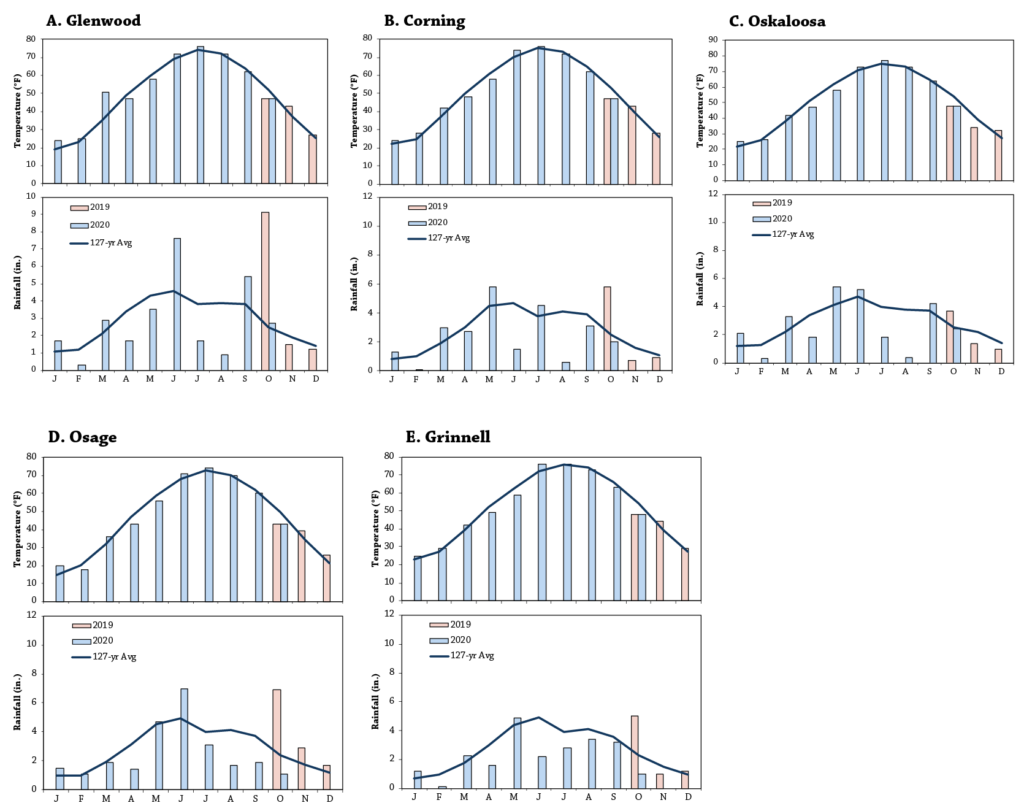
FIGURE A2. Mean monthly temperature and rainfall during the study period and the long-term averages at the nearest weather stations to each farm.[6] A) Glenwood (Bakehouse, about 14 miles away); B) Corning (Douglas, about 11 miles away); C) Osage (Amundson, about 4 miles away); D) Grinnell (Watson, about 13 miles away).
Funding Acknowledgement
This material is based upon work supported by the Natural Resources Conservation Services, U.S. Department of Agriculture, under number NR186114XXXXG003. Any opinions, findings, conclusions, or recommendations expressed in this publication are those of the authors and do not necessarily reflect the views of the U.S. Department of Agriculture.
References
- Acharya, J., M.G. Bakker, T.B. Moorman, T.C. Kaspar, A.W. Lenssen and A.E. Robertson. 2017. Time Interval Between Cover Crop Termination and Planting Influences Corn Seedling Disease, Plant Growth, and Yield. Plant Disease. 101:591–600. https://apsjournals.apsnet.org/doi/pdf/10.1094/PDIS-07-16-0975-RE (accessed April 2019).
- Nelson, H., J. Bakehouse, S. Bennett, M. Douglas, W. Fredericks, J. Gustafson, M. Jackson, D. Norby, A. Robertson, J. Acharya, E. Ogle and T. Gunther. 2020. Comparing Cereal Rye Seeding Dates and Rates In Corn. Practical Farmers of Iowa Cooperators’ Program. https://practicalfarmers.org/research/comparing-cereal-rye-seeding-dates-and-rates-in-corn/ (accessed February 2021).
- Gailans, S. and J. Boyer. 2015. Effect of Seeding Date on Cover Crop Performance. Practical Farmers of Iowa Cooperators’ Program. https://practicalfarmers.org/research/effect-of-seeding-date-on-cover-crop-performance/ (accessed April 2020).
- Gailans, S. and J. Boyer. 2019. Does Repeated Use of a Cereal Rye Cover Crop Reduce the Need for N Fertilizer for Corn? Practical Farmers of Iowa Cooperators’ Program. https://practicalfarmers.org/research/does-repeated-use-of-a-cereal-rye-cover-crop-reduce-the-need-for-n-fertilizer-for-corn/ (accessed October 2020).
- Johanns, A. 2021. Iowa Cash Corn and Soybean Prices. A2-11. Ag Decision Maker. Iowa State University Extension and Outreach. www.nass.usda.gov/Statistics_by_State/Iowa/ (accessed March 2021).
- Iowa Environmental Mesonet. 2020. IEM “Climodat” Reports. Iowa State University Department of Agronomy. http://mesonet.agron.iastate.edu/climodat/ (accessed December 2020).




